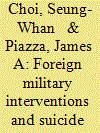|
|
|
Sort Order |
|
|
|
Items / Page
|
|
|
|
|
|
|
| Srl | Item |
| 1 |
ID:
082513


|
|
|
|
|
| Publication |
2008.
|
| Summary/Abstract |
Deconstructing the shariatic justification of suicide bombings reveals a standard reasoning based on four arguments. Two of them relativize the shariatic prohibition against suicide whereas the other two analogize suicide bombings with the medieval combat tactic of plunging alone into the enemy. Prerequisites of a "martyrdom operation" are the suicide bomber's intention to seek martyrdom and his ability to damage the enemy. The reasoning declares the killing of oneself for the sake of Islam permissible and thereby distinguishes "martyrdom operations" from suicide. Deconstructing this and other Islamist doctrines of violence can be of operational use to intelligence and criminal investigations
|
|
|
|
|
|
|
|
|
|
|
|
|
|
|
|
| 2 |
ID:
120437


|
|
|
|
|
| Publication |
2013.
|
| Summary/Abstract |
This article explores the relationship between suicide bombings and public cleric statements in Pakistan between 2000-2010. It establishes that bombings and statements increase over time, that cleric statements vary according to the bombing target, and that police and military targets most frequently garner clerics' attention. An adaptation of Kaplan, Mintz, and Mishal's (2006) maximum likelihood estimation method determines whether cleric statements affect the bombing rate. The analysis shows that pro-suicide statements have a far greater effect on the bombing rate than anti-suicide statements, both in the magnitude of increased bombings and by the length of time over which they exert influence.
|
|
|
|
|
|
|
|
|
|
|
|
|
|
|
|
| 3 |
ID:
151150


|
|
|
|
|
| Summary/Abstract |
This study examines the effect of foreign military interventions on the incidence of suicide attacks. It presents three theoretical explanations. Foreign military interventions may boost insurgent use of suicide attacks by (a) fomenting a nationalist backlash that sanctions the use of more extreme and unconventional tactics like suicide attacks, (b) providing more and better targets against which suicide attacks can be launched, or (c) prompting insurgents to use suicide tactics in order to overcome their power asymmetries and to confront better defended targets that are enhanced by interventions. We test these competing explanations using a battery of statistical tests on cross-national, time-series data for 138 countries during the period from 1981 to 2005. We find that only foreign interventions with specific features—pro-government interventions involving larger numbers of ground troops—boost suicide attacks in countries experiencing interventions. This finding suggests that by tipping the balance of power against insurgents and hardening targets in the context of assisting a local government, foreign military interventions are likely to increase the use of suicide attacks by regime challengers.
|
|
|
|
|
|
|
|
|
|
|
|
|
|
|
|
| 4 |
ID:
140030


|
|
|
|
|
| Summary/Abstract |
What threat do foreign Arab jihadists returning from the war in Syria and Iraq pose to their home states and the broader Arab world? Foreign fighters come back as hardened veterans, steady in the face of danger and skilled in the use of weapons and explosives. While in the conflict zone, they will form networks with other radicals, embrace techniques like suicide bombings and beheadings, and establish ties to jihadists around the world. Different countries have different mitigating factors that limit the danger. The presence or absence of strong and focused security services is particularly important. Returnees' ambition, regional focus, lack of discipline, and brutality often mean they create more enemies than they vanquish and anger local populations. Most terrorism will be locally and regionally focused, with international terrorism probably less of a priority. Area regimes can reduce the risk of bleedout by hindering the travel of volunteers and constraining their ability to organize, stressing the internecine nature of the violence in the Sunni Muslim community, and developing effective de-radicalization programs. Regional and international cooperation to monitor and disrupt travel is also valuable. Many regimes, however, are also likely to take advantage of the jihadists' presence to gain more support from the United States, delay democratic reforms, and crackdown on non-jihadist opposition. Improving intelligence sharing and offensive counterintelligence is important, and the United States can play an important facilitating role.
|
|
|
|
|
|
|
|
|
|
|
|
|
|
|
|
| 5 |
ID:
091853


|
|
|
|
|
| Publication |
2009.
|
| Summary/Abstract |
As the hydra-headed monster of terrorism reared its head, from soft targets to hard, and from suicide bombings to fidayeen-style attacks, the month of October saw Pakistanis' nerves set on edge. Public morale was hit hardest by attacks on government, police and military installations that targeted the country's governance and security infrastructure. The Herald reviews this development by speaking to military and security analysts.
|
|
|
|
|
|
|
|
|
|
|
|
|
|
|
|
| 6 |
ID:
147695


|
|
|
|
|
| Summary/Abstract |
This study asserts that countries with large internally displaced populations (IDPs) are more likely to experience a higher rate of suicide terrorism. After demonstrating this, the study tests four intervening factors hypothesized to drive the relationship between IDPs and suicide attacks: IDPs are expected (1) to increase the pool of potential suicide recruits, thereby lowering the labor costs for suicide terrorist groups; (2) to increase local ethnic conflicts that foster a favorable environment for suicide terrorism; (3) to worsen the human rights conditions in countries, prompting aggrieved people to support suicide terrorist tactics; and (4) to raise the counterterrorism and policing costs of the state, enabling terrorists to plan and execute suicide attacks. Results from negative binomial regression and Tobit models show evidence for the IDPs-suicide terrorism connection. When recursive models are employed to evaluate the effects of four intervening variables, the results most consistently support human rights violations as a significant and substantive mediator between IDPs and suicide attacks.
|
|
|
|
|
|
|
|
|
|
|
|
|
|
|
|
| 7 |
ID:
101267


|
|
|
|
|
| Publication |
2010.
|
| Summary/Abstract |
While suicide terrorism has received tremendous attention from the general public, media and policy-makers in recent years, there are only a few studies that analyze public opinion on political violence in general and terrorism in particular. The article seeks to determine the correlates of support for suicide terrorism among the Lebanese and Palestinians living in South Lebanon and the Palestinian territories. Specifically, it examines the influence of religious and socio-economic factors on their attitudes towards suicide bombings. The analysis is based on four surveys conducted in Lebanon and the Palestinian territories in 2002, 2003 and 2007. The findings show that generally, militant religious view is the most important predictor of the respondents' support for suicide terrorism.
|
|
|
|
|
|
|
|
|
|
|
|
|
|
|
|
| 8 |
ID:
123955


|
|
|
|
|
| Publication |
2013.
|
| Summary/Abstract |
A hallmark of the resurgence of antigovernment forces in Afghanistan was the mass introduction of suicide terrorist attacks. Between 2005 and 2006, the incidence of suicide bombings increased more than fivefold, marking a sea change in the Afghan conflict. Despite the initial jump in the volume of suicide attacks and the fear of more violence, the number of attacks actually flat-lined while the level of other attacks increased. This study will argue that it is the competency of the attackers employed in Afghanistan, not the politics, technology, or targeting, that best explains the static level of suicide attacks.
|
|
|
|
|
|
|
|
|
|
|
|
|
|
|
|
| 9 |
ID:
053541


|
|
|
|
|
| Publication |
New Brunswick, Transaction Publishers, 2004.
|
| Description |
xiv, 246p.
|
| Standard Number |
0765802503
|
|
|
|
|
|
|
|
|
|
|
|
Copies: C:1/I:0,R:0,Q:0
Circulation
| Accession# | Call# | Current Location | Status | Policy | Location |
| 048556 | 303.625/SHA 048556 | Main | On Shelf | General | |
|
|
|
|
| 10 |
ID:
079527


|
|
|
|
|
| Publication |
2007.
|
| Summary/Abstract |
This article develops sequential game models for key operational terrorist (how often to attack) and government (how often to execute targeted killings) decisions taken during a (counter-) terror campaign such as the second intifada. Key results include the following: The government initiates targeted killings when the marginal number of Israeli civilian lives saved from prevented terror attacks exceeds the marginal number of Palestinian civilian lives lost in such ``hits''; targeted killings are not employed if they are either ineffective or extremely effective at thwarting terror (since terrorists will not induce their use); even after accounting for downstream terror attacks motivated by prior targeted killings, a civilian casualty-minimizing government can optimally order targeted killings over time; and low-level cycles of violence can occur when the government is more patient than the terrorists, but higher, stable levels of violence result when the terrorists are the more patient players in the game
|
|
|
|
|
|
|
|
|
|
|
|
|
|
|
|
| 11 |
ID:
164066


|
|
|
|
|
| Summary/Abstract |
What strategic logics underlie terrorist groups’ use of linked suicide attacks? Are the goals that groups seek to achieve when sending linked bombing teams somehow inherently different than when sending individual suicide bombers? To answer these questions, this article introduces three typologies of linked suicide bomber detonation profiles—simultaneous, sequential, and nonproximate—and theorizes why terrorist groups might view each type of linked suicide bombing to be preferable to deploying a single suicide bomber. Improvements resulting from using an individual attacker include: ensuring a higher likelihood of successfully hitting a given target (simultaneous detonations); causing more casualties than a single bombing (sequential-wave detonations); and engendering wider-spread shock and awe (nonproximate detonations). Drawing on an original dataset detailing the entirety of Boko Haram’s suicide bombing efforts from 2011 to 2017, we then examine the extent to which these linked bombing typologies do actually appear to successfully lead to an improvement over the deployment of single suicide bombers. While we find that sequential-wave and nonproximate suicide bombings demonstrate evidence of hypothesized improvements over the deployment of single suicide bombers, our data show that deploying simultaneous suicide attackers does not lead to higher efficacy at targeting when compared to the deployment of individual bombers. In attempting to account for this fact, we argue that Boko Haram’s simultaneous detonation teams likely fail to show an improvement over single-bomber attacks because they tend to be composed of what we call “unenthusiastic and under-trained” bombers: teams of often uncommitted women, and sometimes children, which it deploys in tandem in a bid to avoid individual defection and increase the likelihood of at least one detonation in an attack. We conclude by suggesting what the process of linked bombing reveals about both terrorist groups in general and Boko Haram specifically.
|
|
|
|
|
|
|
|
|
|
|
|
|
|
|
|
|
|
|
|
|